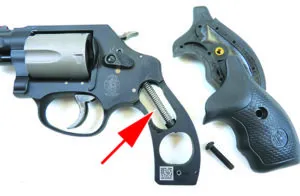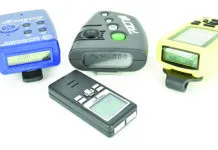You would be hard pressed to find something more effective in a defensive situation than a 357 Magnum revolver. The cartridge provides more velocity and energy than the more popular 9mm Luger round. The 9mm and 357 Magnum both use similarly-sized bullets, but because the 357 Magnum case is longer, it can hold more powder, which translates to about 30 percent more velocity, and depending on the load, about 70 percent more energy. Certainly, the 357 is ballistically superior to the 9mm, but that magnum power comes at a cost, and that is recoil, as we found out in a recent test of 357 Magnums sized for everyday carry (EDC). We had four guns, three from Smith & Wesson and one from Rossi, the RP63 with a 3-inch barrel. The S&W contenders included the Model 360 PD 163064 with a 1.88-inch barrel and two Performance Center guns, a Model 19 Carry Comp 13323 with a 2.5-inch barrel and a Model 60 Pro Series 178013 with a 3-inch barrel. All of these revolvers are built on either a small- or medium-size frame, are chambered in 357 Magnum, have exposed hammers, have double-action and single-action triggers, and have abbreviated barrels ideal for concealed carry.
How We Tested
Before going the range, we checked the cylinder-to-frame headspace with a feeler gauge and a range-rod match kit ($130; Brownells.com) to check barrel and chamber alignment. All chambers and bores aligned. Check. Typically, the space from the forcing cone to the front of the cylinder should be from 0.004 to 0.010 inches. All measured 0.008 inches except for the Model 19, which was tighter at 0.006 inches. Check. The bigger this gap, the more lead splash can be expected when shooting. We did not experience lead gap splash with the revolvers.
For accuracy testing, we fired the revolvers in single action using a rest. Targets were set at 15 yards. For speed shooting, we used NRA D-1 tombstone targets at 7 yards, firing a fully loaded cylinder as fast as possible in double action while trying to keep hits in center mass.
We fired both 38 Special and 357 Magnum ammo. The Aguila 357 Magnum ammo had 158-grain semi-jacketed soft-point (SJSP) bullets. The Blazer 38 Special +P loaded a 125-grain jacketed hollow point, and the Speer Gold Dot 38 Special had 125-grain Gold Dot hollow points. All of these rounds are good choices for self defense. Different calibers and loads were also loaded into the revolvers so we didn’t know what to expect. Recoil ranged from stout with the 357 Mag ammo to mild with 38 Specials. If our high school physics teacher had used a lightweight 357 Magnum revolver to demonstrate Newton’s Third Law, which states that for every action (force) in nature, there is an equal and opposite reaction, we would have paid better attention.
The top line is that all of these 357s are suitable for self defense, but some are better than others. As you know, there are always some “buts” in every review, so we get into the very fun weeds below.
Smith & Wesson Model 360 PD 163064 357 Magnum
$1100
Gun Tests grade: A- (OUR PICK)
The Model 360 PD is the gun to carry all day, but that light weight makes for terrific recoil with 357 Magnum ammo. The fiber-optic front sight pops. Accuracy was good.

| Action Type | Revolver, double action, single action |
| Overall Length | 6.3 in. |
| Barrel | 1.88 in. long |
| Overall Height | 4.7 in. |
| Maximum Width | 1.3 in. |
| Weight Unloaded | 11.8 oz. |
| Weight Loaded | 13.8 oz. |
| Cylinder Gap | 0.008 in. |
| Capacity | 5 |
| Frame | J-Frame, matte black scandium |
| Barrel | Matte-black stainless steel |
| Cylinder | Matte-gray titanium |
| Frame Front Strap Height | 1.8 in. |
| Frame Back Strap Height | 3.1 in. |
| Grip | Textured rubber w/finger grooves |
| Grip Thickness Maximum | 1.2 in. |
| Grip Circumference Maximum | 4.6 in. |
| Front Sight | Hi-Viz fiber-optic orange tube, pinned |
| Rear Sight | Fixed notch |
| Sight Radius | 3.0 in. |
| Trigger Pull Weight Double Action | 13.0 lbs. |
| Trigger Pull Weight Single Action | 4.0 lbs. |
| Trigger Span Double Action | 2.9 in. |
| Trigger Span Single Action | 2.3 in. |
| Safety | Internal rebound, hammer block |
| Warranty | 1 year |
| Telephone | (800) 331-0852 |
| Website | Smith-Wesson.com |
| Made In | U.S. |
The third S&W in this match up is the Model 360 PD, a J-frame five-shot revolver with a scandium frame and titanium cylinder. Unloaded, it weighs 11.8 ounces. This is a very lightweight revolver we love to carry concealed but hate to shoot. Recoil is horrendous when shooting 357 Magnum ammo. If you decide to go this route, consider yourself forewarned.
The barrel is 1.8 inches long and wears a Hi-Viz fiber-optic front sight. The rear sight is a fixed groove milled into the top strap. The synthetic grip has one finger groove and a slight palm swell that is near perfect for concealed carry. Average- to large-hand shooters need to curl their small fingers under the butt. The shape of the grip allowed for a high hold.
The titanium cylinder has a matte-gray finish. S&W recommends not to use Magnum loads with bullet weights lighter than 120 grains to reduce the possibility of premature erosion in the titanium-alloy cylinder. Not to worry, if we owned this revolver, we would not be shooting a lot of 357 Magnum ammo through it. The frame is matte black, and the trigger and hammer are case colored. The narrow, low-profile hammer is serrated and was easy to cock. The thin trigger was smooth on the face. The safety features include an internal rebound hammer and hammer block, so it is very safe to carry.

In hand, the 360 PD is a lot like other J-frame snubnose revolvers except for its very light weight. The double-action trigger pull measured a heavy 13 pounds; single-action mode measured 4 pounds. Not a target trigger by any means.
Going hot, we learned to deal with the terrific — in the bad sense — recoil. Firing 357 Magnum ammo was painful, but even with pounded palms, the smallest group with the Aguila 357 Magnum measured 1.67 inches. The muzzle flipped up with authority. You need to pay attention with this revolver. Moving to the less-powerful 38 Special +P ammo, recoil was still stiff and unpleasant. The best group measured 1.01 inches, which was the smallest group we eked out of the tiny 360 PD. Shooting 38 Special is more tolerable, but still not a lot of fun. The smallest group with the Speer Gold Dot measured 1.79 inches. Overall, the Model 360 PD had the worst accuracy of the quartet, with an average across all ammos that measured 2.89 inches. Worst compared to the other revolvers, but still very much in the accuracy zone for a defensive handgun.
Rapid fire was tough on the hands. The orange fiber-optic front sight was very easy to acquire, and at 7 yards, the center of the tombstone target was a challenge. It also became easier to master, especially with softer-recoiling 38 Special ammo.
Our Team Said: While the recoil was stout, the 360 PD would be Our Pick as an EDC. The light weight and compact size make for carry comfort. The grip makes the 360 PD a natural pointer and we imagine that if we unleashed 357 Magnum power on some bad actor, we would not feel the stout recoil. This is not a gun to shoot a lot, but it is definitely a gun to carry a lot.
| 357 MAGNUM AND 38 SPECIAL RANGE DATA | ||||
| Aguila 357 Magnum 158-grain SJSP | Rossi RP63 | S&W Model 19 Carry Comp | S&W PC Pro Series Model 60 | S&W Model 360 PD |
| Average Velocity | 1115 fps | 1074 fps | 1110 fps | 1009 fps |
| Muzzle Energy | 436 ft.-lbs. | 405 ft.-lbs. | 432 ft.-lbs. | 357 ft.-lbs. |
| Smallest Group | 1.37 in. | 1.66 in. | 1.67 in. | 2.16 in. |
| Average Group | 1.98 in. | 2.02 in. | 2.10 in. | 3.23 in. |
| Blaser 38 Sp. +P 125-grain JHP | Rossi RP63 | S&W Model 19 Carry Comp | S&W PC Pro Series Model 60 | S&W Model 360 PD |
| Average Velocity | 990 fps | 862 fps | 980 fps | 830 fps |
| Muzzle Energy | 272 ft.-lbs. | 206 ft.-lbs. | 267 ft.-lbs. | 191 ft.-lbs. |
| Smallest Group | 1.24 in. | 0.98 in. | 1.01 in. | 1.66 in. |
| Average Group | 1.74 in. | 1.27 in. | 2.25 in. | 2.87 in. |
| Speer Gold Dot 38 Sp. 125-grain GDHP | Rossi RP63 | S&W Model 19 Carry Comp | S&W PC Pro Series Model 60 | S&W Model 360 PD |
| Average Velocity | 815 fps | 782 fps | 807 fps | 744 fps |
| Muzzle Energy | 184 ft.-lbs. | 170 ft.-lbs. | 181 ft.-lbs. | 154 ft.-lbs. |
| Smallest Group | 0.99 in. | 1.81 in. | 1.79 in. | 2.06 in. |
| Average Group | 1.38 in. | 2.02 in. | 2.58 in. | 2.09 in. |
To collect accuracy data, we fired five-shot groups from a bench using a rest. Distance: 15 yards with open sights. We recorded velocities using a ProChrono DLX digital chronograph set 10 feet from the muzzle. SJSP = semi-jacketed soft point. JHP = jacketed hollow point. GDHP = Gold Dot hollow point.
Written and photographed by Robert Sadowski, using evaluations from Gun Tests Team members. GT



























